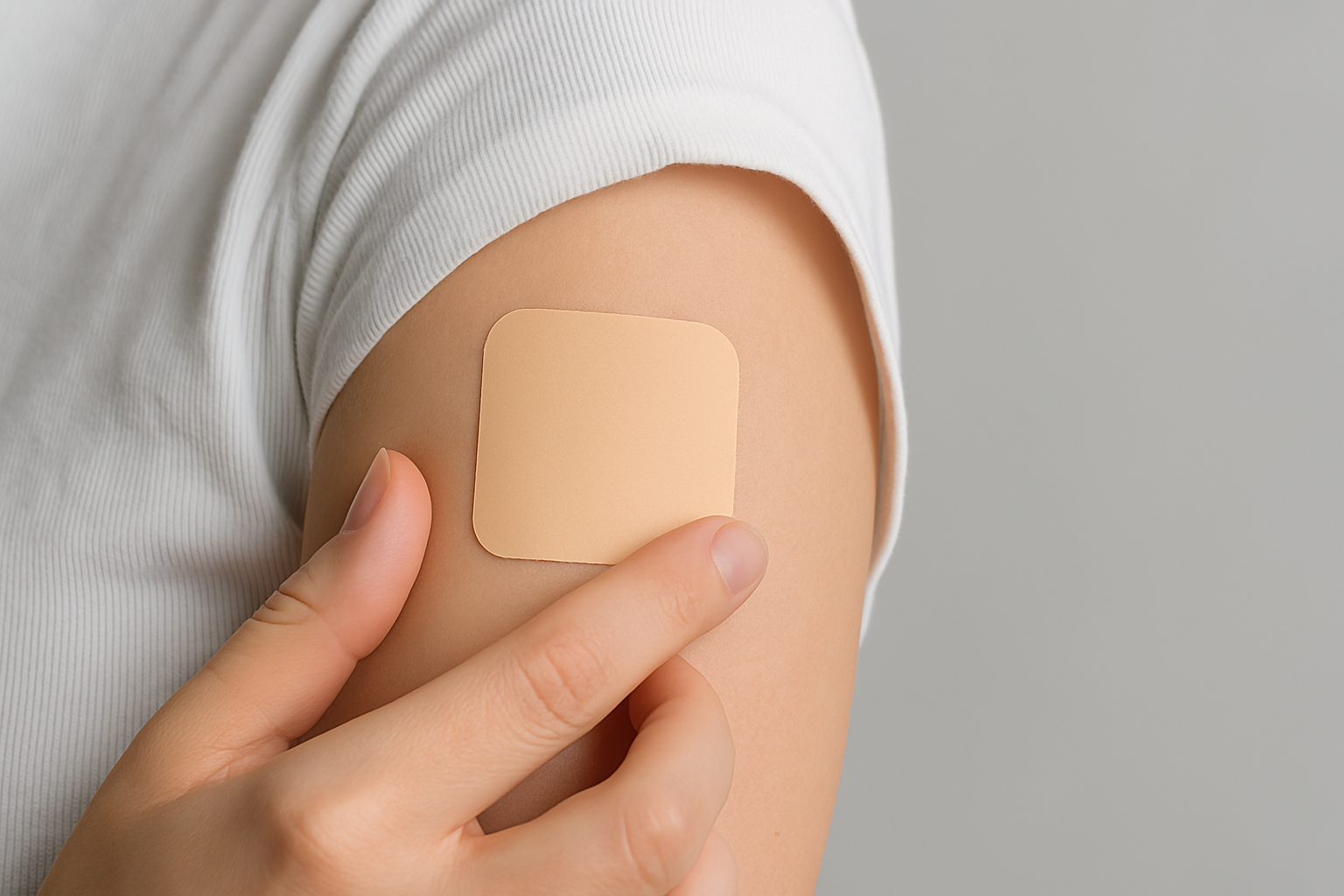Looking for an easy way to increase low testosterone without the shots or the gels? A transdermal patch is your best option. Put it on before bed, take it off the next night, and your skin does the rest. The patch delivers a steady and even stream of hormone just like all transdermal systems, and no needles and no “Did I wash my hands after the gel” anxiety. Simply apply the patch and forget.
Ease is not the only benefit. As medicine is delivered through a transdermal patch, the medicine in a patch avoids first-pass liver metabolism and creates smoother hormone levels than pills. Smoother hormone levels lead to a reduction in roller-coaster moods from testosterone, and a reduction in the risk of random high hormone spikes.
If you are ready to see if a tiny piece of technology can help reduce fatigue, brain fog, and low drive, read on.
Key Takeaways
- With a transdermal patch, testosterone seeps through skin all day, dodging liver metabolism and sparing users from needles or messy gels.
- Steady hormone delivery curbs roller-coaster moods, boosting daily energy, sharper focus, and consistent drive for men battling hypogonadism.
- Androderm patches release roughly four milligrams nightly, peaking eight hours post-application then cruising inside the healthy 400-930 ng/dL window.
- Rotating patch sites weekly—back, abdomen, upper arm, or thigh—prevents irritation, keeps adhesive strong, and protects smooth hormone absorption.
- Common hiccups include mild itching or redness; serious issues like swelling or high blood counts demand immediate healthcare follow-up.
Table of Contents
Transdermal Patch Basics
A transdermal patch is a thin, medicated sticker you place on clean, dry skin; usually your back, abdomen, upper arm, or thigh. Inside the patch is a reservoir of testosterone held tight by special layers that let the drug seep out slowly over 24 hours. Your skin’s outer layer acts like a filter, letting small hormone molecules glide into tiny blood vessels underneath.
Because the hormone enters your circulation directly, it bypasses the stomach and liver. That reduces the strain those organs feel when processing oral drugs and lowers the risk of liver‑related side effects.
Doctors prescribe patches mainly for male hypogonadism, when your body can’t make enough natural testosterone. One common brand, Androderm, releases roughly 4 mg of testosterone daily. Blood tests two weeks after starting confirm that morning testosterone sits in the healthy 400‑930 ng/dL window; if not, the dose may rise to 6 mg.
The patch’s slow release keeps hormone levels steadier than many gels or injections. In studies of hypogonadal men, serum testosterone peaks eight hours after application and then levels off, staying in range for the full day. That steady profile helps cut drastic ups‑and‑downs in energy or mood.
Because testosterone travels through intact skin, site rotation is vital. Never stick a new patch on the exact spot you used yesterday; wait at least seven days to prevent irritation. If redness occurs, over‑the‑counter hydrocortisone can soothe the area. Remove the patch before MRI scans, because the backing may contain metal that heats up.
Another plus: minimal risk of accidental transfer to family members, something gels struggle with. Once the patch is covered by clothing, the medication stays put until you peel it off.
How To Use A Transdermal Patch Safely: Quick, Expert‑Approved Guide
- Prep your skin. Wash with mild soap, rinse, and dry fully, moisture weakens the adhesive. Skip lotions or oils on patch days.
- Pick the right spot. Choose the back, abdomen, upper arm, or thigh—places with few body hairs and little pressure during sleep. Avoid bony spots or areas that bend or sweat a lot.
- Stick firmly. Press the patch edges for 10 seconds to seal, especially after showers. If it falls off before 12 hours, replace it; otherwise, wait until the next scheduled change.
- Rotate sites. Move clockwise around your chosen regions so each area rests a full week before seeing another patch. Your skin will thank you.
- Track levels. A simple morning blood draw two weeks after starting—or after any dose change, confirms you’re in range. Your provider may tweak the dose or patch strength.
- Watch for side effects. The most common issues are mild: itching, redness, or a small blister under the patch. Rare but serious problems include swelling of the ankles, sleep apnea flare‑ups, or high red‑blood‑cell counts. Tell your doctor at once if you notice shortness of breath, severe skin pain, or sudden mood changes.
Benefits you’ll likely notice:
- Steadier energy because levels stay in the “Goldilocks” zone—neither too high nor too low.
- Smoother moods since daily dosing avoids weekly peaks common with injections.
- Lower mess factor compared with gels that can rub off on kids or partners.
- Liver‑friendly delivery, avoiding first‑pass metabolism.
When a patch might not be right for you:
- Active skin disease like psoriasis in patch areas
- Severe sleep apnea or high prostate‑specific antigen (PSA) levels
- Uncontrolled heart failure or recent stroke
Always discuss these with your healthcare team before starting therapy.
Take Charge of Your Testosterone
Frequently Asked Questions
Choose clean, dry skin on your back, abdomen, upper arm, or thigh. Rotate sites so the same spot isn’t used for a full week.
Yes—heart disease, sleep apnea, thick blood, and prostate changes remain possible. Regular labs and exams keep you safe.
No testosterone patch is FDA‑approved for women; past trials showed limited benefit and safety concerns.
If it’s been on less than 12 hours, put on a fresh one. If longer, wait until your usual change time. Never “double‑stack” patches to catch up.

